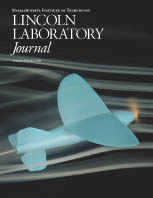Publications
Volume 9, Number 2
 |
|
Space-Time Adaptive Processing on the Mesh Synchronous Processor This article examines the suitability of the Mesh synchronous processor (MeshSP) architecture for a class of radar signal processing algorithms known as space-time adaptive processing (STAP), which is an important but computationally demanding technique for mitigating clutter and jamming as seen by an airborne radar. The computational requirements of STAP algorithms, combined with the need for programming flexibility, have motivated Lincoln Laboratory to investigate the application of massively parallel processors to the STAP problem. These processors must be sufficiently flexible to accommodate different STAP architectures and algorithms, and must be scalable over a wide parameter space to support different radar systems. This article describes performance models and methods of estimating MeshSP efficiency on representative STAP algorithms to assess the potential use of MeshSP in airborne STAP applications. Nonconventional 3D Imaging Using Wavelength-Dependent Speckle We describe a technique known as speckle-pattern sampling for noncontact measurement of an object's surface contour. In this technique, the object is flood illuminated by a tunable laser, and the wavelength and spatial dependence of the resulting speckle pattern in the scattered light are Fourier analyzed to yield a 3D image of the scattering surface. The theoretical analysis includes a treatment of image aberrations and near-field effects. The technique is demonstrated with laboratory measurements that show good agreement with results from standard contact-based measurements. Range resolutions of better than 10 mm are achieved. This technique has two principal advantages over many other noncontact methods: the range resolution does not degrade as the distance to the object increases, and the source and receiver lie in the same direction so that the image is not affected by shadowing. Improved Localization of Energy Deposition in Adaptive Phased-Array Hyperthermia Treatment of Cancer Elevated cell tissue temperature (hyperthermia) due to radio-frequency (RF) energy absorption is known to produce an improved response for malignant tumors in humans when applied in combination with other anticancer modalities. Clinical studies in thermotherapy have shown the difficulty of localizing RF energy deposition in malignant tissue deep within the body without damaging surrounding healthy tissue. The study presented in this article involves a preclinical investigation of adaptive feedback and computer control of amplitude and phase from coherent RF antenna arrays to provide improved distribution of electromagnetic energy deposition in the body. Measurements in a treatment-planning phantom irradiated with an adaptive antenna-array applicator show that noninvasive adaptive nulling can reduce the RF energy absorption in nearby healthy tissue while focusing energy into a deep-seated tumor site. Micro Air Vehicles for Optical Surveillance We present a study of micro air vehicles (MAVs) with wingspans of 7.4 to 15 cm. Potential applications for MAVs, both military and civilian, are numerous. For most military applications, MAVs would be controlled by local users, operating covertly, to supply real-time data. This article focuses on a military surveillance application that uses either visible or infrared imaging sensors. We present concepts for these sensors as well as for a miniature Ka-band communications link. Because of the close coupling between vehicle elements, system integration is a significant challenge, requiring tight packaging and multifunction components to meet mass limitations. We conclude that MAVs are feasible, given approximately two to three years of technology development in key areas, including sensors, propulsion, aerodynamics, and packaging. MAVs would be affordable if manufactured in quantity by using microfabrication techniques. |
|